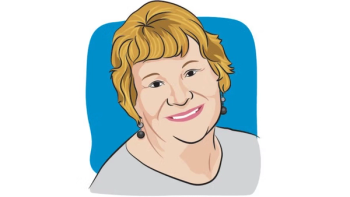
Monocytosis in Myelodysplastic Syndromes
Episodes in this series

Hetty Carraway, MD: One of the things I find really interesting is that for many of our patients, we look at their differential. For patients who have a monocytosis or have had a monocytosis for a number of months, it can be something that is evasive and has been present for many months but hasn’t been noticed by the primary care doctor. Can you talk about the presence of monocytosis and how that factors into the work-up for a patient with MDS [myelodysplastic syndrome] and what you do with that information?
Guillermo Garcia-Manero, MD: It is a very important issue. When we say you look at the CBC [complete blood count], it’s simple but a little more complex than just looking at those three parameters. Many times, before we go to the monocytes, the clue is just looking at the MCV [mean corpuscular volume], this parameter in the CBC that lets you see how big or small those cells are, and that is already potentially an indicator of what may be happening in that bone marrow. Most patients with MDS have an increased MCV value.
This is totally anecdotal, if you’ll allow me two seconds. I’ve had a very interesting patient for many years who has a type of leukemia that is very easy to cure. He and his wife are engineers who work for a company that makes them do a yearly blood analysis. He’s very smart. He asked me to look at why the MCV, in a totally normal CBC, has increased substantially over 20 years. I said, “I don’t know.” But his wife had very early stage low-risk myelodysplastic syndrome. There is no indication for therapy. But I was fascinated to see the value go from the 70s to 110 fL over 20 years. I expect that the doctors may sometimes miss this.
The monocyte is really important because when you look at the differential, you are looking to see if the neutrophil count is decreased, and sometimes you may see some blasts. These are kind of leukemic cells. But in a subset of patients, we see this increase in the cells that are monocytes, and that can be seen in a disorder that we call chronic myelomonocytic leukemia, or CMML. Until very recently, we used to consider this a subtype of MDS.
Today this is considered a different entity, but it shares a lot of the same characteristics and thought process that we use in myelodysplastic syndrome, although the disease can have a different behavior. Sometimes those patients may present more with inflammatory types of symptoms or with a little fever, night sweats, or lack of appetite. This is a rare condition that we approach a little differently from myelodysplastic syndrome, but you could see it by this growing number of cells.
You need to understand that it’s not the percentage that you look for. You actually look at the absolute number of these cells. Sometimes people say, “Oh, this percentage is off.” But the number is actually normal. The CBC can provide a lot of information if you pay attention to it.
Hetty Carraway, MD: I love your story about families and patients or caregivers paying attention to all the details of that information. That does allow them to have a better handle on what things mean and which things are important, particularly at the time of diagnosis but even as we manage their MDS over time.
Guillermo Garcia-Manero, MD: Hetty, let me emphasize this. This is crucial, particularly in this COVID-19 time. A few years ago, one of my really dear patients was a very intelligent man who was a very accomplished lawyer. We had to admit him to the hospital because he required a more intensive therapy. I was rounding on the patient that month, and almost every day we talked about how we were looking at the end of the month for the percentage of blasts and minimal residual disease.
At the end of the month, we did the bone marrow test, and he was MRD [minimal residual disease] negative. I was so excited. He was living in the hotel attached to The University of Texas MD Anderson Cancer Center, and I called him. I told him he was MRD negative, and he went silent. “What’s happening?” he asked. “Doctor, I don’t understand what you’re saying.” I told him, “This is because my accent is so bad.” He said, “No, no. I don’t know what MRD means.” I said, “But I’ve explained to you almost daily that this is what we were looking for.” So I said, “Let’s meet together.” This is two seconds from my research office. He said, “When you are in that room, we pretend that we understand, but 90 percent flows over. We’re so stressed and this is so difficult that things that are very easy for you are extremely complex for us.” And this was a patient with incredible intellect.
That was one time that I was really shocked by this because things like the MCV or monocytes are very simple. Our patients tend to be older, and when they come to this clinic by themselves without support, this is critical. For years, I’ve tried to make sure that the family somehow is there or on the phone, on FaceTime. You need to make sure that you have an extra set of eyes and ears listening to these conversations because this is very complex, and sometimes it is not that easy to convey whatever message you are giving. This is now becoming crucial. With COVID, the way we’re practicing is going to stay with us for a long period of time—at least the coming year—so we need to make a big effort to communicate better with our patients because this is a really complex set of disorders. So your question is right on target.
Hetty Carraway, MD: Thank you for that story. I think it can be overwhelming for patients and for caregivers to try to wrap their heads around this big word, myelodysplastic syndrome, because it’s such a medical term. Typically, when I’m describing to patients, I try to explain to them that it’s really that this bone marrow is a factory in making three cell lines: white blood cells, red blood cells, and platelets. In the bone marrow factory itself, there’s an issue with quality control. It’s an issue of quantity and quality.
There is a decreased production of cells, whether it’s the red blood cells, the white blood cells, or the platelets, and also a decrease in terms of the quality or functioning of those cells. For example, the majority of patients present with anemia. In that setting, those red blood cells are made at lower numbers, and the red blood cells that are there are just not as good with their oxygen-carrying capacity as a normal red blood cell. That combination of both those entities, quantity and quality, lead to many of the symptoms that patients with myelodysplastic syndromes have.
There are different ways we can look at these cells, both in quantity and quality. When we talk about these numbers, and as we eventually continue to manage patients, they begin to realize what the numbers are that we’re looking at, why we are looking at them, and why we are focusing on them in terms of this bone marrow factory. Ultimately, the data that we collect and go over repeatedly really matter.
Within the diagnosis of MDS, we were talking a little about that bone marrow aspirate and how the chromosome tests help us identify what chromosomes might put a patient at higher risk of progression to leukemia versus somebody that may be less at risk. Some of those details—with regard to the number of cell lines affected, the types of chromosomes changed, and the blast population, or the percentage of leukemia cells—ultimately help us clarify the risk for a patient with MDS, whether it’s a lower or higher risk.
Transcript Edited for Clarity















